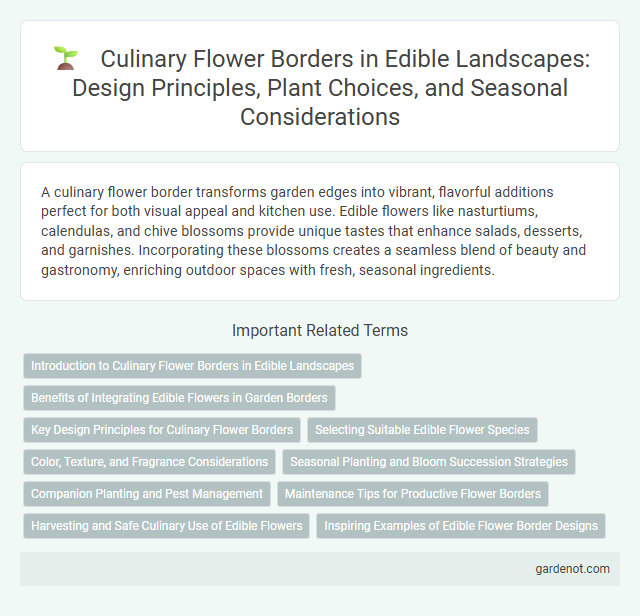A culinary flower border transforms garden edges into vibrant, flavorful additions perfect for both visual appeal and kitchen use. Edible flowers like nasturtiums, calendulas, and chive blossoms provide unique tastes that enhance salads, desserts, and garnishes. Incorporating these blossoms creates a seamless blend of beauty and gastronomy, enriching outdoor spaces with fresh, seasonal ingredients.
Introduction to Culinary Flower Borders in Edible Landscapes
Culinary flower borders integrate vibrant, edible blossoms such as nasturtiums, calendula, and chive blossoms to enhance both flavor and aesthetics in edible landscapes. These flowers offer unique tastes ranging from peppery to citrusy, complementing herbs and vegetables while attracting pollinators essential for garden health. Strategically planting culinary flower borders boosts biodiversity and provides fresh, seasonal ingredients for creative culinary use directly from the garden.
Benefits of Integrating Edible Flowers in Garden Borders
Integrating edible flowers in garden borders enhances biodiversity while providing vibrant, nutrient-rich blooms that boost culinary creativity. These flowers attract pollinators, improving overall garden health and yield. Their aesthetic appeal combined with practical use transforms traditional borders into sustainable, multifunctional food sources.
Key Design Principles for Culinary Flower Borders
Culinary flower borders thrive by integrating diverse edible blossoms such as nasturtiums, calendulas, and chive flowers to maximize flavor and visual appeal. Strategic layering with varying heights and continuous seasonal bloom cycles ensures an abundant harvest and vibrant display throughout growing seasons. Soil health and pollinator-friendly companion plants significantly enhance flower nutrition and attractiveness, optimizing both culinary use and ecological benefits.
Selecting Suitable Edible Flower Species
Selecting suitable edible flower species for a culinary flower border involves considering flavor profiles, growth habits, and climate adaptability. Popular choices include nasturtiums, calendula, and pansies, which offer vibrant colors and unique tastes while thriving in various soil conditions. Ensuring the flowers are free from pesticides and grown organically enhances both safety and flavor quality for culinary use.
Color, Texture, and Fragrance Considerations
A culinary flower border enhances an edible landscape by combining vibrant colors, diverse textures, and enticing fragrances to create an appealing sensory experience. Flowers like nasturtiums, calendulas, and borage provide bright hues, unique leaf shapes, and aromatic qualities that complement edible plants while attracting pollinators. Selecting varieties with contrasting petal colors, varied leaf textures, and distinct scents ensures a visually stunning and flavorful garden border.
Seasonal Planting and Bloom Succession Strategies
Implementing seasonal planting and bloom succession strategies in a culinary flower border ensures a continuous harvest of edible blossoms throughout the growing season. Selecting diverse species like nasturtiums, borage, and calendula with staggered flowering times maximizes bloom overlap and extends production from spring to fall. Integrating cool-season and warm-season varieties creates a resilient edible landscape that supports year-round culinary use and garden biodiversity.
Companion Planting and Pest Management
Culinary flower borders enhance edible landscapes by incorporating companion planting techniques that improve plant health and yield. Flowers such as nasturtiums and marigolds repel harmful pests like aphids and whiteflies, reducing the need for chemical interventions. Integrating these blooms promotes a balanced ecosystem, attracting beneficial insects like pollinators and predatory wasps essential for natural pest management.
Maintenance Tips for Productive Flower Borders
To maintain a productive culinary flower border, regularly deadhead spent blooms to encourage continuous flowering and prevent seed formation. Soil should be enriched with organic compost every 4-6 weeks to provide essential nutrients, ensuring vibrant, flavorful petals. Consistent watering is crucial, ideally keeping the soil moist but not waterlogged, to support healthy growth and maximize harvest of edible flowers like nasturtiums, pansies, and calendulas.
Harvesting and Safe Culinary Use of Edible Flowers
Harvest edible flowers from culinary borders in the early morning when petals are freshest and free from dew or pesticides. Choose fully open blooms, avoiding flowers that are wilted or discolored to ensure safety and optimal flavor. Rinse petals gently with cool water and use them immediately in recipes to maintain nutritional value and vibrant taste.
Inspiring Examples of Edible Flower Border Designs
Edible flower borders showcase vibrant varieties such as nasturtiums, calendula, and borage, blending aesthetics with culinary utility in garden designs. These borders not only enhance visual appeal with bursts of color but also provide fresh, flavorful petals for salads, garnishes, and herbal teas. Integrating herbs like chives and lavender alongside edible flowers creates a multisensory experience that supports pollinators and encourages sustainable gardening.
Culinary flower border Infographic

 gardenot.com
gardenot.com